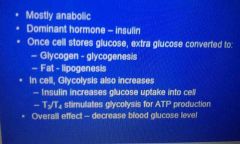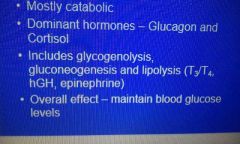![]()
![]()
![]()
Use LEFT and RIGHT arrow keys to navigate between flashcards;
Use UP and DOWN arrow keys to flip the card;
H to show hint;
A reads text to speech;
23 Cards in this Set
- Front
- Back
|
Salivary glands |
Produces amylase in moistens food for swallowing |
|
|
Esophagus |
Where peristalsis begins, transports food to stomach |
|
|
Esophageal sphincter...stomach |
Prevent acidic chyme from entering esophagus |
|
|
Stomach |
Storage sites food, where protein digestion begins |
|
|
Rugae...stomach |
Increase volume of stomach |
|
|
Pyloric sphincter....stomach |
Regulates entry of chyme into duodenum |
|
|
Small intestines |
Completes digestion and most absorption |
|
|
Large intestine |
Forms feces, absorbs water, vitamins and electrolytes |
|
|
Pancreas |
Produces digestive enzymes and bicarbonate, produces hormones to regulate carbohydrate metabolism |
|
|
Liver |
Interconverts nutrients, produces bile, detoxifies substances like drugs, alcohol, produces plasma proteins |
|
|
Gallbladder |
Stores and concentrates bile |
|
|
Circular Folds...small intestine |
Mucosa and submucosa Falls that slow down time movement to maximum absorption |
|
|
Villi....small intestine |
Finger like mucosal projections,most numerous and duodenum ,contain lacteals and capillaries for absorption |
|
|
Microvilli....small intestines |
Contain carbohydrate and protein enzymes to complete digestion |
|
|
Haustra... Large intestine |
Sacs that form from smooth muscle bands |
|
|
Ileocecal valve |
Separates the small and large intestines... Limit the reflux of cologne and contacts into the ileum |
|
|
Anabolism |
-Reactions that combine monomers to form complex molecules... Dehydration synthesis - endergonic reactions - stores energy in bonds |
|
|
Catabolism |
Chemical reaction that breaks down complex molecules into simpler ones AKA hydrolysis - exergonic - releases stored energy... Most energy lost as heat and rest of energy transferred to ATP |
|
|
Glucose catabolism |
1. Glycolysis - in the cytosol 2. Acetyl Co a 3. Krebs cycle... Citric acid cycle 4. Electric transports chain Etc |
|
|
Lipid catabolism |
1. Lipolysis occurs first... Triglyceride breakdown 2. Beta oxidation breaks down fatty acid chains to fatty acid group packages |
|
|
Protein catabolism |
_ stimulated by cortisol - amino acids enter glycolysis Krebs cycle or as acetylcholine |
|
|
Absorptive state |

|
|
|
Post absorptive State |

|

